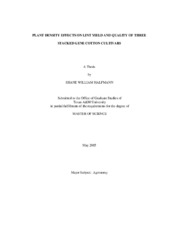| dc.description.abstract | The increased cost of planting transgenic or stacked gene cotton cultivars has
stimulated interest in determining the optimal planting density for commercial
production. If seeding rates can be reduced without adversely affecting lint yield and
fiber quality, producers could regulate initial inputs by fluctuating seeding rates.
However, manipulating plant density per unit area can affect the growth and
development of the crop. This altered growth throughout the season could potentially
affect fiber quality. Fiber properties, which dictate price discounts, are determined by
maturity, diameter and length, as well as by physiological activity at the cellular level.
These fiber properties are also affected by genetics and environmental conditions, which
ultimately can impact lint production as well as the location of bolls set throughout the
plant and the maturation period. The objective of this study was to examine the impact
of plant density (including high, ideal and low densities) on growth and development of
transgenic cotton cultivars. Field experiments were conducted in 2003 and 2004 at the
Texas Agricultural Experiment Station in Burleson County, Texas to assess the effects of
plant density on lint yield and fiber quality. Experimental design was a spit-plot design with four replications of three cultivars (SG 215 BG/RR, DP 555 BG/RR, ST 4892
BG/RR) in densities ranging from 74 to 222 thousand plants hectare-1.
Plant density had no significant effect on lint yield in 2003 or 2004. However,
low plant density treatments contained significantly more bolls plant-1 as a result of the
plantÂ’s compensatory ability to produce the same number of bolls in a given area. These
low density treatments also produced more vegetative biomass plant-1. Due to lower boll
numbers and lower ginout percentage, ST 4892 produced the lowest lint yield each year.
Lint quality was not significantly affected by density or cultivar treatments either year.
However, in 2003 micronaire values were within the discount ranges for ST 4892, and
the two lowest density treatments. | en |


